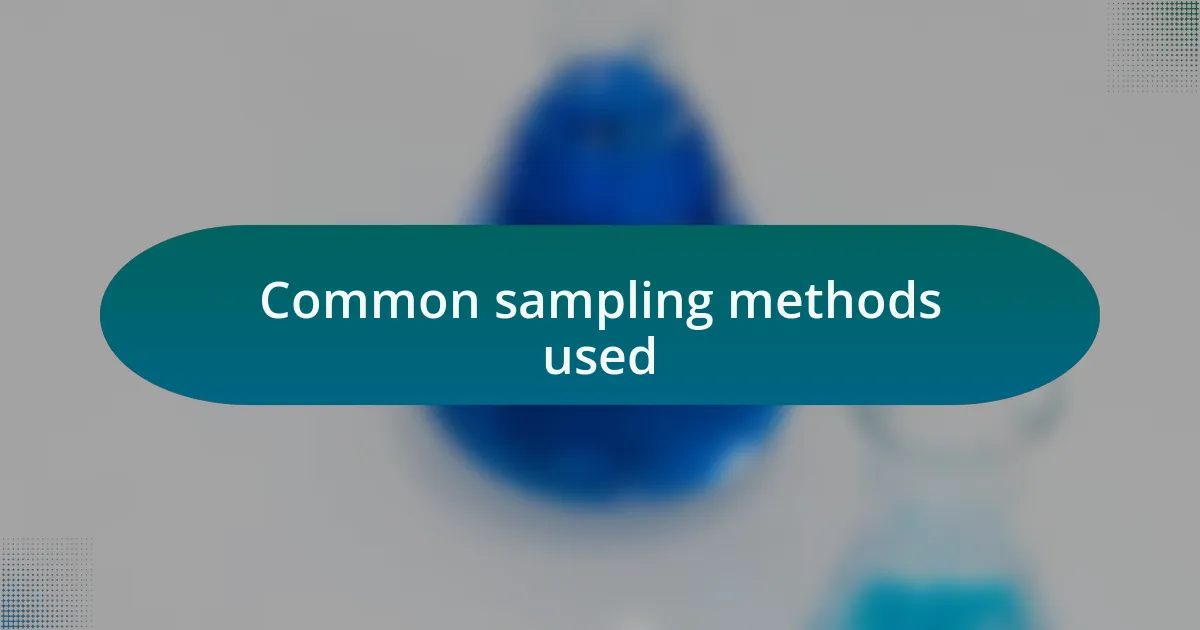Key takeaways:
- Effective sampling is vital for research credibility; both quantity and quality of the sample matter.
- Understanding the target population’s characteristics can enhance sampling strategies and ensure accurate findings.
- Choosing the right sampling method (random, stratified, or purposive) aligns with research objectives and available resources.
- Engaging with the target population early and ensuring sufficient sample size can lead to richer, more meaningful data insights.

Understanding effective sampling in research
Effective sampling in research is crucial because it directly influences the reliability and validity of your findings. I remember a time when I underestimated the importance of a well-structured sample size for a project I was working on. The data collected ended up skewed, and it taught me that the right sample can make or break your study’s credibility.
When sampling, it’s essential to consider not just the quantity, but also the quality of your sample. Have you ever thought about how a small focus group can yield more meaningful insights than a large, diverse group? In my own experience, targeted sampling has often revealed deeper patterns that a broader approach missed entirely. I find that this insight fosters a richness in the data that resonates on a more personal level, and it encourages me to think critically about who is included in my research.
Moreover, understanding the specific characteristics of your target population can significantly enhance the effectiveness of your sampling strategy. Early in my career, I overlooked this aspect, and it resulted in findings that didn’t truly reflect the experiences of my subjects. It was a pivotal moment; I learned how demographic factors can shape experiences, and that tailoring my sample not only enriches the data but also respects the voices of those involved.

Common sampling methods used
When exploring common sampling methods, I often find myself drawn to random sampling. This approach gives every member of the population an equal chance of being selected, which can lead to findings that genuinely represent the broader group. I recall a project where I employed this method, and I was pleasantly surprised when the diversity of my sample contributed to robust and unexpected insights.
On the other hand, stratified sampling has its advantages too. By dividing the population into distinct subgroups, I can ensure that each group is adequately represented in my research. One time, I used stratified sampling for a study on educational outcomes, and it helped me uncover significant differences between various age groups. Could you imagine missing those insights by not considering the nuances within the population?
Another method worth mentioning is convenience sampling, which, admittedly, can be tempting at times. It involves selecting individuals who are easily accessible, making the process quicker and simpler. However, I learned the hard way that while it’s convenient, it can also lead to biased results. Have you ever relied on this method only to find that your findings didn’t align with the broader context? That experience taught me the value of careful consideration over mere ease, even when time is of the essence.

Criteria for selecting sampling techniques
When selecting sampling techniques, one critical criterion is the research objectives. I remember a study where I was examining public sentiment on environmental policies; my goal was to gauge varied opinions across demographics. This awareness guided my choice of stratified sampling, ensuring that voices from different age groups and backgrounds were heard. Doesn’t it make sense to align your sampling strategy with what you truly want to discover?
Another essential factor is the population size. In a previous project, I was tasked with surveying a small community about their shopping habits. Given the size, convenience sampling initially seemed workable. However, I realized that my small sample size could introduce bias that skewed my findings. This experience reinforced my belief that understanding the population’s scale is fundamental; it can shape whether your approach is robust or merely superficial. Have you ever been caught in a situation where you underestimated the importance of population size?
Lastly, the resources at your disposal also play a vital role in deciding on sampling techniques. During one research project with a tight budget and limited time, I gravitated towards simple random sampling, which was both efficient and effective. It’s striking how often resource constraints can drive decisions in research. Have you ever had to make tough choices based on what was available rather than what you ideally wanted? This taught me that sometimes, the practicalities of a project can lead to innovative solutions when approached creatively.

My personal sampling strategy outline
When I outline my personal sampling strategy, I first focus on the goals of my research. For instance, while working on a project about social media’s impact on youth, I opted for purposive sampling to specifically target individuals who actively engage on various platforms. Have you ever considered how defining your endpoint can drastically alter who you choose to include in your sample?
Next, I assess the dynamics of the population I am studying. In one project assessing mental health awareness among college students, I found that using snowball sampling was incredibly effective. This method allowed me to reach individuals through referrals, which made it easier to connect with a demographic that often hesitates to participate in studies. Isn’t it fascinating how leveraging existing networks can unlock access to hard-to-reach populations?
Finally, I place significant emphasis on adaptability in my sampling approach. I vividly remember a survey that aimed to explore the effectiveness of remote learning during the pandemic. Initially, I planned for stratified sampling to capture varied educational backgrounds but quickly shifted to a mixed-method approach. This flexibility allowed me to gather both quantitative data and qualitative insights, enriching my overall findings. Have you recognized how sometimes the ability to pivot can enhance your research outcomes?

Tips for successful sampling execution
One effective tip for successful sampling execution is to engage directly with your target population early in the process. I recall a project where I organized focus groups before finalizing my sample. It not only helped me fine-tune my questions but also built trust with participants, which is crucial for honest responses. Have you ever thought about how a simple conversation could lay the groundwork for deeper insights?
Another important aspect is ensuring that your sample size is adequate to reflect the diversity of the population. In a study I conducted on dietary habits, I initially underestimated the number of participants needed. Once I expanded my sample, I discovered surprising trends across different demographics, which ultimately enriched my findings. Isn’t it interesting how sometimes more data can reveal stories that smaller samples may overlook?
Lastly, don’t underestimate the power of follow-up. After completing a survey, I reached out to participants for additional thoughts, which provided context to their responses. This not only improved my understanding but also demonstrated my commitment to valuing their input. Have you noticed how a little extra engagement can turn a standard sample into a vibrant, narrative-driven dataset?